The citizen participation process including presentations, discussions, public hearings, letters and comments has been long and arduous. The issues are complicated and sometimes feelings run high. In such situations, there can be a feeling that citizens have not been heard. This document, “Guide to Zoning Amendments Related to Multifamily Uses and Mixed-Use“, summarizes many of the issues that have been raised and the changes that have been made in the zoning Articles as a result of the citizen participation in the public review process. Citizens have been heard.
Related articles
In 2015 Town Meeting approved the Master Plan. Following is the Housing chapter of that plan. It contains a great deal of information about details of the housing situation in Arlington, challenges of housing price increases, needs for specialty housing, opportunities for meeting these needs, etc. The authors found that “most cities and towns around Arlington experienced a significant rise in housing values from 2000 to 2010. A 40 percent increase in the median value was fairly common. However, Arlington experienced more dramatic growth in housing values than any community in the immediate area, except Somerville. In fact, Arlington’s home values almost doubled.” This and related data helps explain why the need for affordable housing is now so acute.
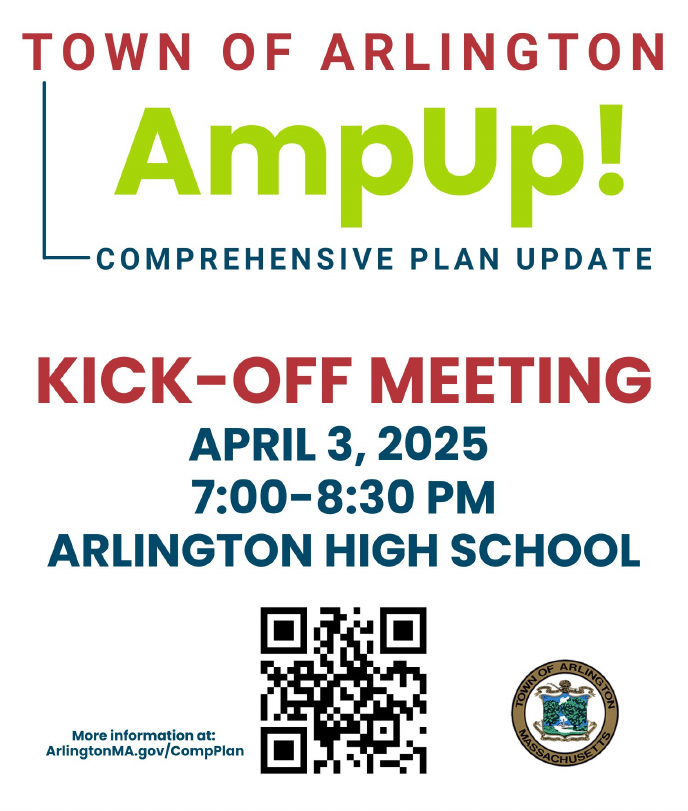
The kick-off event for updating Arlington’s Comprehensive Plan (formerly called the Master Plan) is just around the corner on April 3rd from 7-8:30 PM in the Arlington High School Cafeteria!
A Comprehensive Plan is a long-range plan for the Town, and an opportunity for the community to come together and imagine what Arlington could look like in ten or fifteen years. It covers things like housing, business development, parks and open spaces, town services and facilities, and transportation. The kickoff meeting is the first step in building that vision.
Arlington residents of all ages are invited to attend this event, where you can expect a presentation followed by small group discussions. The effort will continue throughout the year, and it’s important to hear from as many residents as possible. Please join if you can!
For more information and to add the meeting to your calendar, see ArlingtonMA.gov/CompPlan.
A report by Mass Housing Partnership’s Shelly Goehring looks at Arlington’s housing development history and policies to understand how municipal action and inaction can contribute to housing inaffordability and can limit the population diversity within a community. The report implies that it has been difficult historically for reputable housing developers to work with the regulatory structure within Arlington to get housing built.
Massachusetts has the nation’s 2nd largest gap in homeownership between households of color (31% own homes) and white households (69% own homes).
See the complete report for more information.
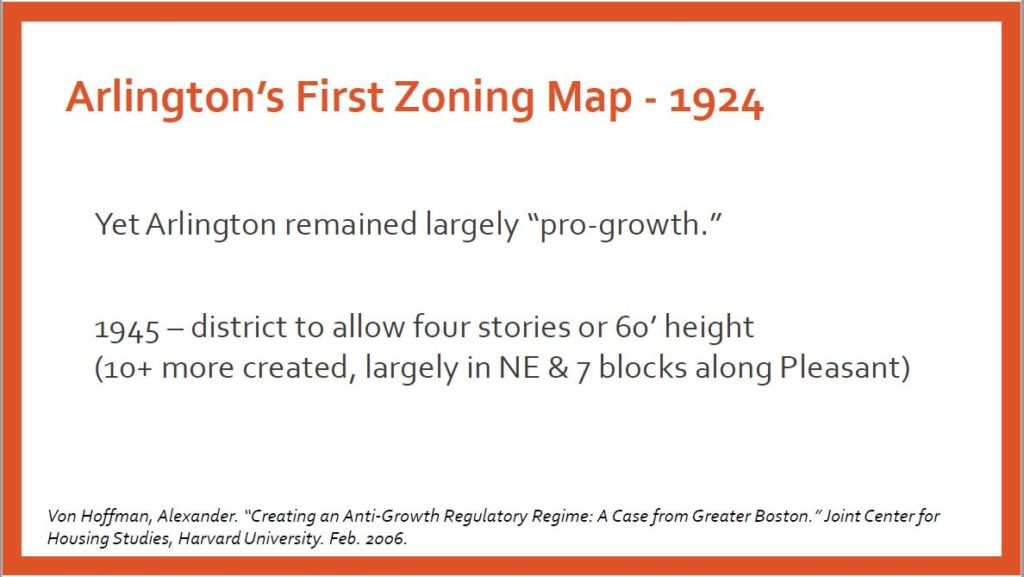
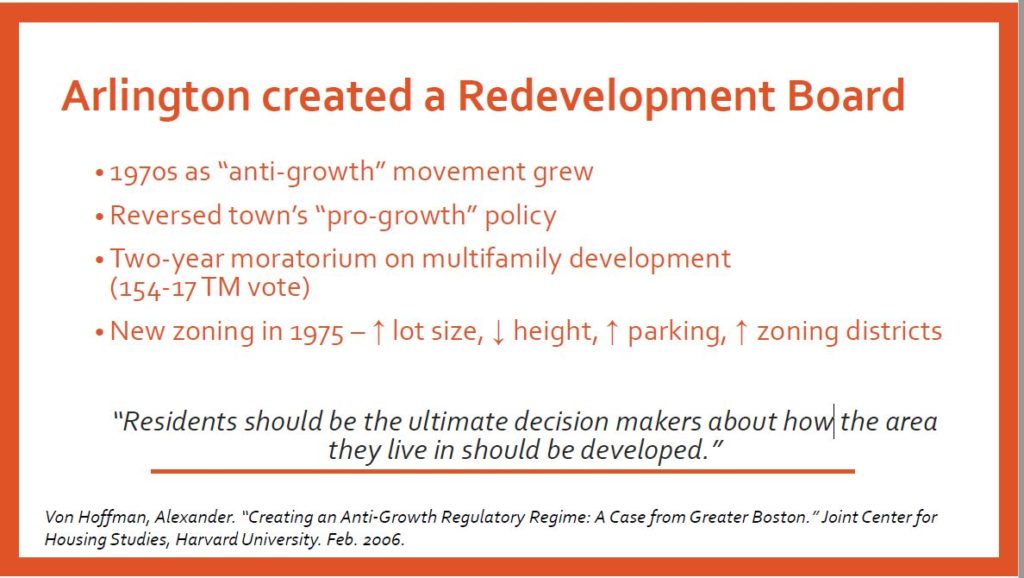
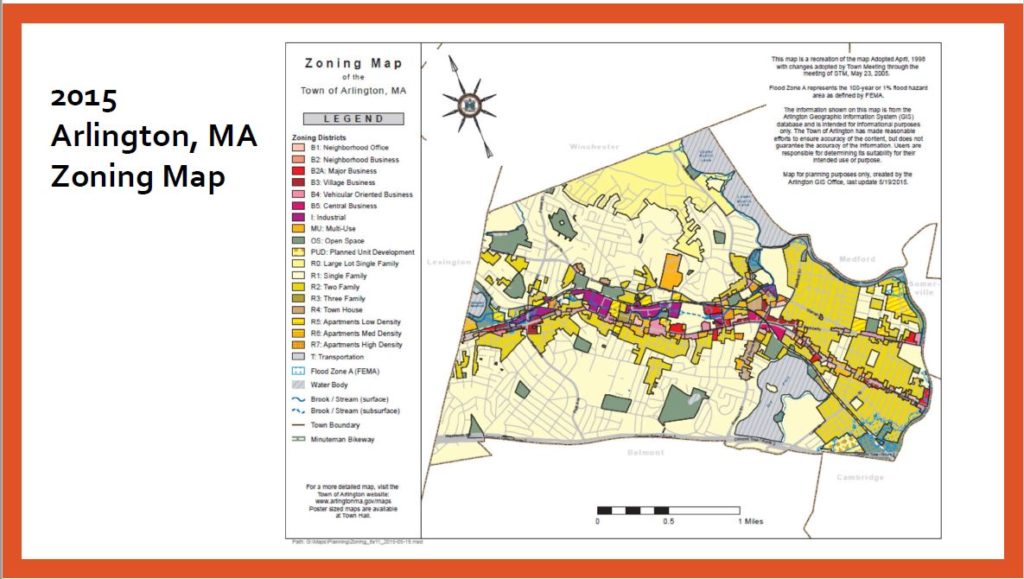
It’s the time of year when folks in Arlington are taking out nomination papers, gathering signatures, and strategizing on how to campaign for the town election on Saturday April 1st. The town election is where we choose members of Arlington’s governing institutions, including the Select Board (Arlington’s executive branch), the School Committee, and — most relevantly for this post — Town Meeting.
If you’re new to New England, Town Meeting is an institution you may not have heard of, but it’s basically the town’s Legislative Branch. Town Meeting consists of 12 members from each of 21 Precincts, for 252 members total. Members serve three-year terms, with one-third of the seats up for election in any year, so that each precinct elects four representatives per year (perhaps with an extra seat or two, as needed to fill vacancies). For a deeper dive, Envision Arlington’s ABC’s of Arlington Government gives a great overview of Arlington’s government structure.
As our legislative branch, town meeting’s powers and responsibilities include:
- Passing the Town’s Operating Budget, which details planned expenses for the next year.
- Approving the town’s Capital Budget, which includes vehicle and equipment purchases, playgrounds, and town facilities.
- Bylaw changes. Town meeting is the only body that can amend the towns bylaws, including ones that affect housing — what kinds can be built, how much, and where.
Town Meeting is an excellent opportunity to serve your community, and to learn about how Arlington and its municipal government works. Any registered voter is eligible to run. If this sounds like an interesting prospect, we encourage you to run! Here’s what you’ll need to do:
- Have a look at the town’s Information for new and Prospective Town Meeting Members.
- Contact the Town Clerk’s office to get a set of nomination papers. You’ll need to do this by 5:00 PM February 12th, 2025 at the latest.
- Gather signatures. You’ll need signatures from at least ten registered voters in your precinct to get on the ballot (it’s always good to get a few extra signatures, to be safe).
- Return your signed nomination papers to the Clerk’s office by February 14, 2025 at 5:00 PM.
- Campaign! Get a map and voter list for your precinct, knock on doors, and introduce yourself. (Having a flier to distribute is also helpful.)
- Vote on Saturday April 5th, and wait for the results.
Town Meeting traditionally meets every Monday and Wednesday at 8:00 PM, starting on the 4th Monday in April (which is April 28th this year), and lasting until the year’s business is concluded (typically a few weeks).
If you’d like to connect with an experienced Town Meeting Member about the logistics of campaigning, or the reality of serving at Town Meeting, please email info(AT)equitable-arlington.org and we’d be happy to make an introduction.
During the past few years, Town Meeting was our pathway to legalizing accessory dwelling units, reducing minimum parking requirements, loosening restrictions on mixed-use development in Arlington’s business districts, and adopting multi-family zoning for MBTA Communities. Aside from being a rewarding experience, it’s a way to make a difference!
Data in a Mass Housing Partnership report shows how far behind the Boston metropolitan area has fallen in meeting the housing needs of its citizens. There are four primary categories for measuring the inadequacies: 1. Availability, 2. Affordability, 3. L0cation and Mobility and 4. Equitability. See the full report for more data and examples. Two slides are shown below.
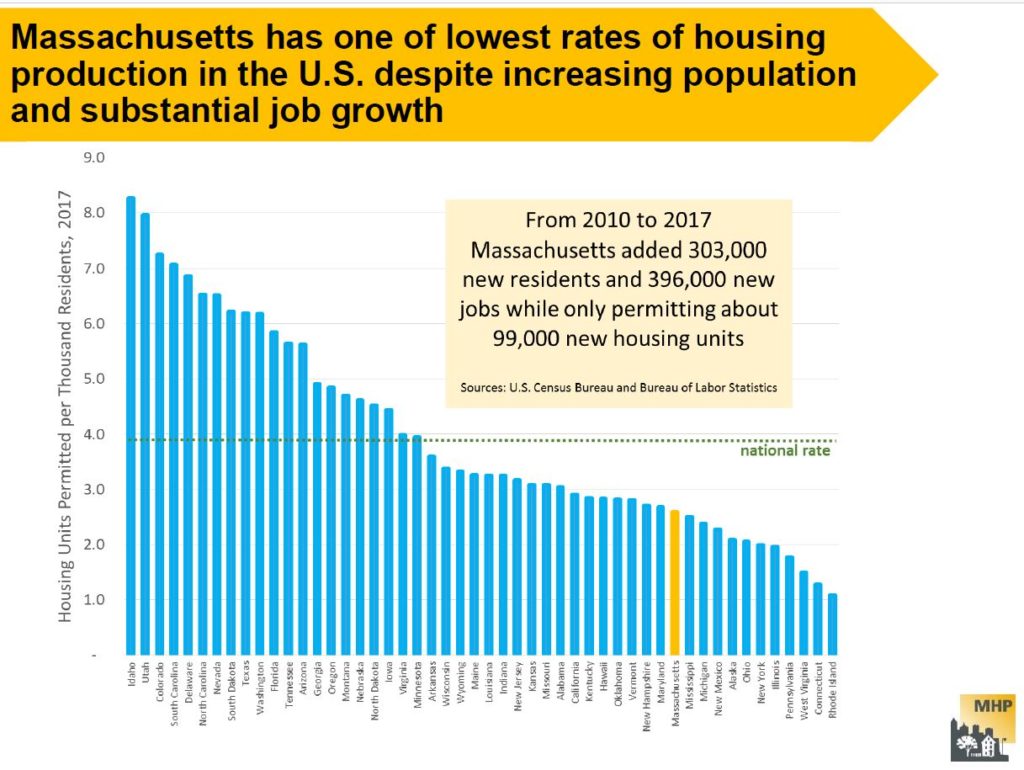
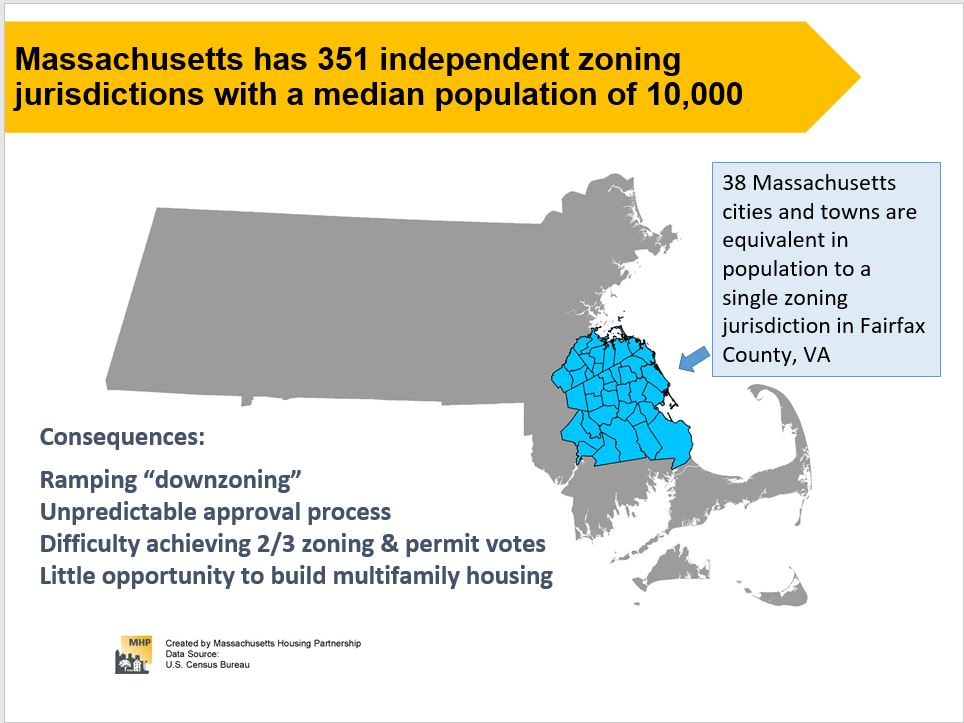

In a 2019 study, MAPC found that:
- Three out of ten spaces sit empty during peak demand
- The key factors that drive parking demand are parking supply, transit accessibility and the percentage of deed-restricted units
This study raises important questions about the wisdom of continuing to commit large sections of the land area of our municipalities to be on reserve for parking cars. Such extra space could be used to benefit the open space, environmental sustainability and the need for more housing.
by Andy Greenspon
Image credit: Henry Hudson Kitson, Public domain, via Wikimedia Commons
In 2023, Lexington was one of the first towns to comply with the State “MBTA Communities” law (MBTA-C) by adding 227 acres to several multifamily overlay zones. When discussing this proposal, it was estimated to possibly generate 400-800 units in 4-10 years. However, after receiving building permit applications for about 1,100 units in the first year (including 160 inclusionary affordable units), Lexington passed Article 2 at a Special Town Meeting recently, which decreased the amount of land in these zones to approximately 90 acres. What can Arlington learn from Lexington’s experience?
Overall, Lexington’s experience shows us that developers are willing and able to build multifamily housing on large lots that aren’t very built up, and that MBTA-C can be successful in adding new housing in some circumstances. However, Arlington has few if any large, sparsely-built parcels zoned to allow multifamily housing under MBTA-C. As such, Arlington is unlikely to add significant amounts of new housing or affordable housing as a result of the MBTA-C overlay passed at Town Meeting in fall of 2023.
Parcel Size and Existing Buildings
Many of the parcels in Lexington’s MBTA-C zone are multiple acres each, are underutilized, and contain older office space. In contrast, Arlington’s MBTA-C parcels are much smaller and mostly covered with existing buildings, typically residential.
The largest development approved under MBTA-C so far in Lexington is at 3-5 Militia Drive. This land is three very large parcels containing a couple older office buildings, a previous religious institution, and giant surface parking lots. Therefore, such a property was already primed for redevelopment and the large lots allowed for 292 units to be approved. These parcels are also within walking distance of Lexington Town Center and the Minuteman Bike path, so multi-family housing on this location is a great use.
In contrast, there are no similar parcels in Arlington in the MBTA-C zone with large surface parking lots and aged office space that could be redeveloped in such a manner. One of the few parcels in Arlington that is somewhat similar to the planned parcels for redevelopment in Lexington would be the Walgreens at 324 Massachusetts Ave, 1.5 acres with a surface parking lot. However, this parcel was specifically excluded from the MBTA-C overlay along with all other business parcels to avoid displacing any existing business space. And the parcel is unlikely to be redeveloped one way or another unless Walgreens chooses to close their business and sell the parcel to a developer.
In short, compared to Lexington, Arlington is “built out” insofar as almost every parcel is utilized in some manner with high lot coverage. The original Lexington MBTA-C zone contained many parcels with low lot coverage, large surface parking lots, and underutilized office space, all attributes that make such parcels more likely to be sold to a developer to construct housing if permitted by zoning.
Last, while 1,100 units have been permitted so far, this does not mean all these units will be constructed given current financial uncertainty in the economy and high interest rates. It will also take several years for these properties to be completed and prepared for occupancy. As such, the original estimate of 400-800 units in 4-10 years (an estimate that actually widely ranges from 40 units all the way to 200 units per year) may in fact not be that far off from the final numbers once buildings are completed. The parcels most primed for redevelopment were acquired and permitted first. Finally, it is not entirely clear how many more parcels would have been redeveloped in the next 5-10 years had the Lexington MBTA-C zoning not been reduced in size.
Development Potential in Arlington
Most privately owned lots in Arlington are less than ⅓ of an acre with many much smaller, significantly limiting the amount of new housing development on any single parcel. Almost all of these lots are covered by existing buildings, and some of those buildings are condominiums. Therefore, in order for a large new construction project to occur on such parcels in Arlington’s MBTA-C multifamily zone, all of the following would have to take place:
- a single owner would have to take control of multiple lots and/or condominiums, meaning that
- multiple existing property owners would have to want to sell at the same time, or else the new owner would have to take the time and risk to assemble the property slowly, and
- the new proposed development would have to be large and profitable enough to make up for the combined purchase prices of all the properties acquired.
Meanwhile, properties in Arlington generally turn over at a fairly slow and steady pace. This is in contrast to underused large commercial properties, whose owners are more eager to sell.
With simulation modeling performed on potential rate of redevelopment, the Arlington Redevelopment Board’s 2023 Report to Town Meeting on the MBTA-C proposal projected that 15–45 parcels could be redeveloped over the next ten years, for a net increase of 50–200 new units or 5–20 per year, far fewer than even the initial Lexington housing unit construction estimates at the time of passage of their initial MBTA-C zoning.
In fact, Arlington has seen even less than the low end estimate of 5 units per year so far since our MBTA-C zoning became effective. Only a single project has been permitted so far, which would turn an existing 2-unit building into 4 units, a potential net gain of 2 housing units.
Lessons
- There is strong regional demand for housing including for multifamily units.
- Developers are currently willing and able to build when lots are available, are zoned multifamily, and aren’t already full of other buildings.
- Arlington can’t expect anywhere near as many new units with our current zoning as Lexington saw, because our MBTA-C multifamily zones are almost exclusively made up of smaller and built-up lots.
- As a result, Arlington’s current zoning won’t add much housing or affordable housing to our community, and won’t noticeably increase our tax base either.
State Senator Cindy F. Friedman has written a letter to Town Meeting Members supporting Warrant Article 12 and a meaningful MBTA Communities Plan. She writes:
We all want Arlington and Massachusetts to remain welcoming, accessible places to live. In addition to our deficit of housing, I recognize the importance of encouraging smaller, more sustainable housing in walkable areas. Arlington’s Warrant Article 12 will provide a meaningful framework for making progress in these areas. The problems we are experiencing now —out of reach housing prices for new construction and existing homes — exacerbate the crisis and are seriously threatening the economic vibrancy of our communities.
To read Friedman’s full letter, click here for the PDF.
